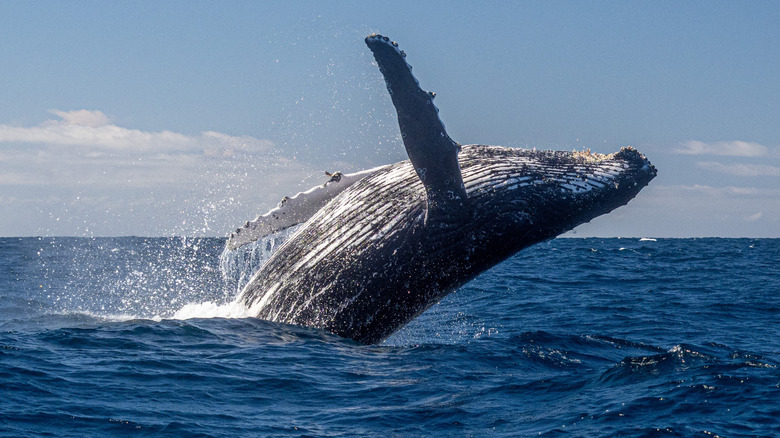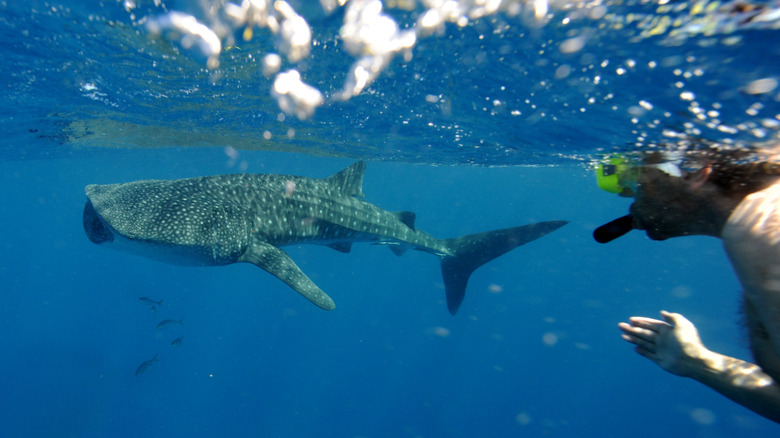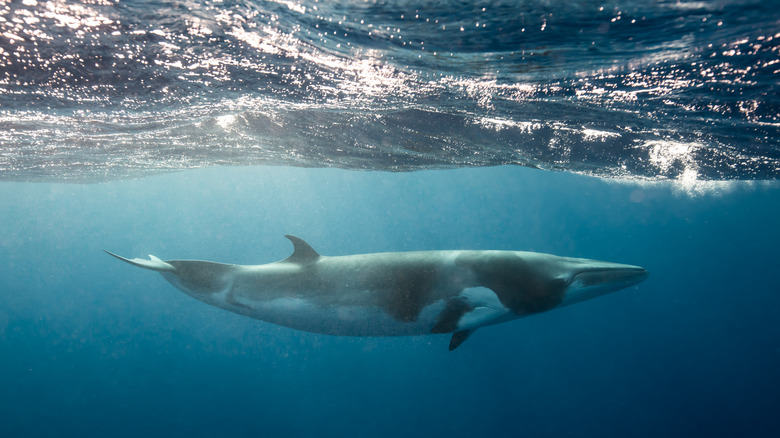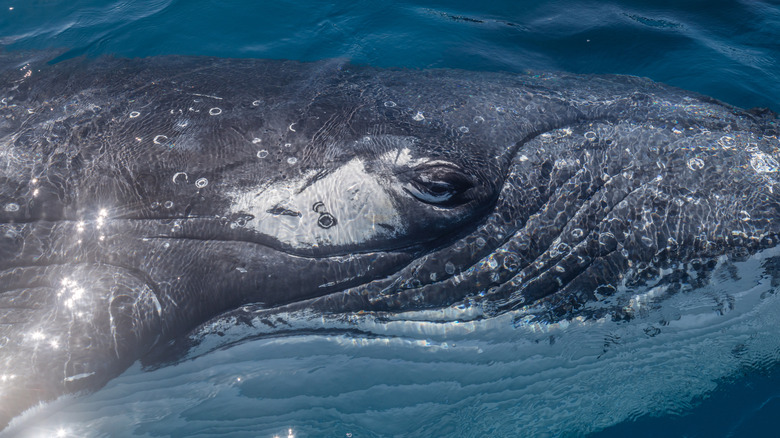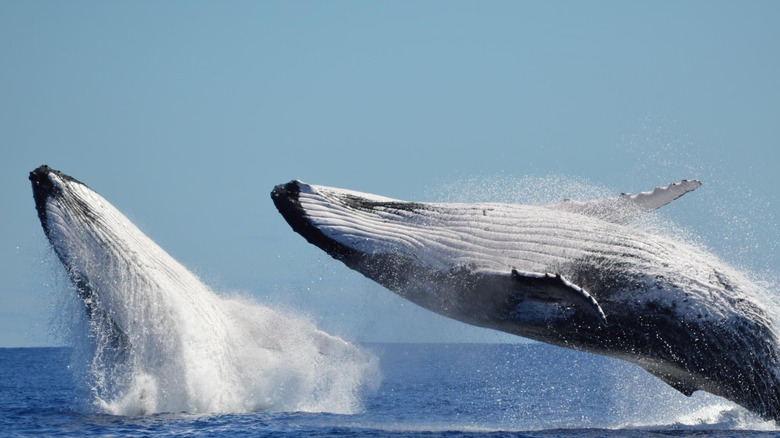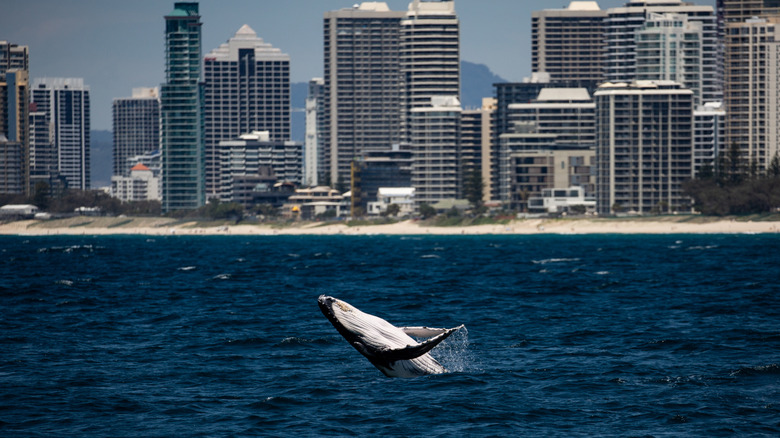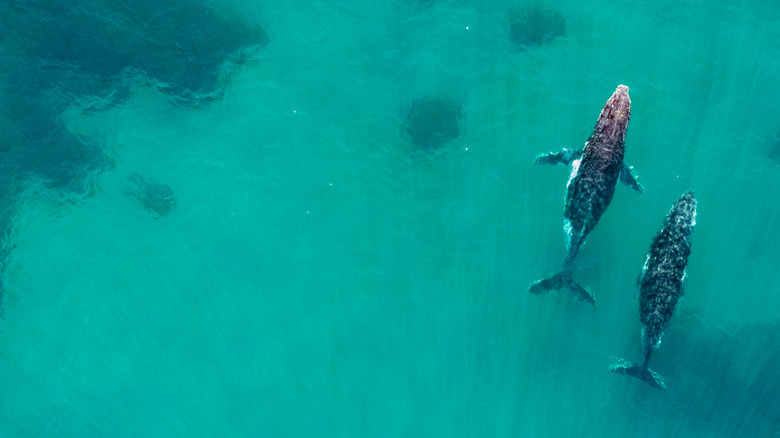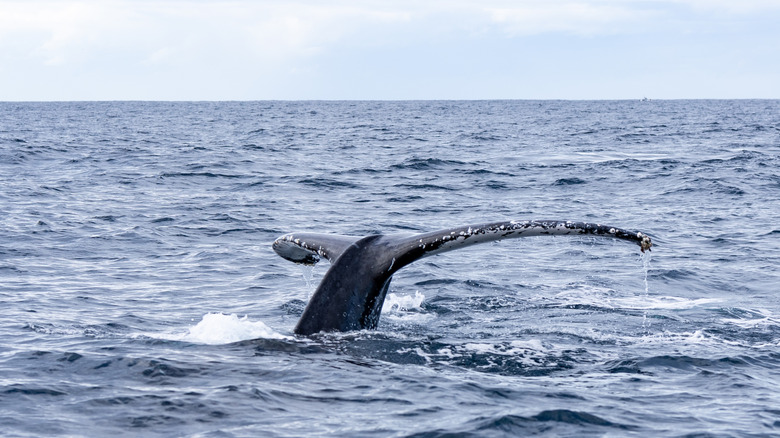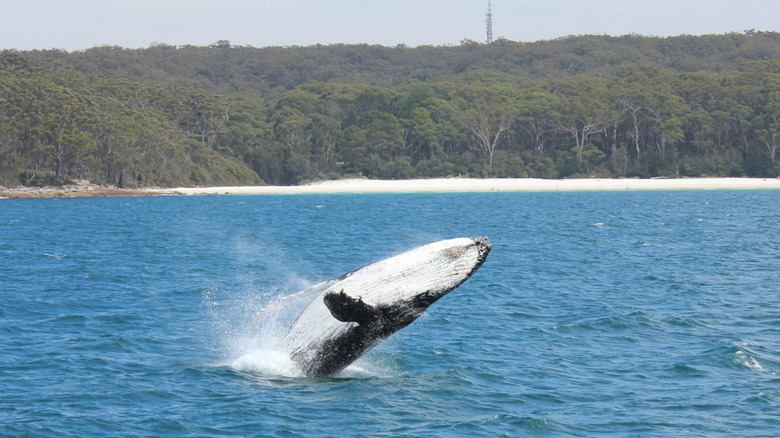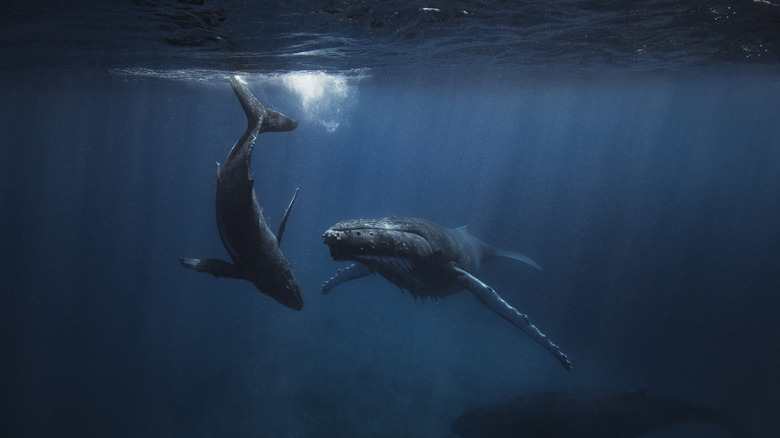The Best Places Along Australia's Coast To Swim With Whales, According To Reviews
The snout breaches the water's surface, and a hiss of sea spray erupts as the giant leaps from the ocean depths. The tail flips upward, and the body crashes in a thunderous explosion of salt water and shimmering white spume. Whale-watching is one of those life-changing travel experiences we all wish to have, and the sheer size of these majestic creatures can send bone-deep shivers down your spine at first sight.
Swimming with these gentle giants takes the experience to a whole new level. Not only can you feel their enormity, but you can also see them gracefully gliding and drifting together as they socialize beneath the waves. And, if you're lucky, you'll experience their deep, melodic singing that you may only have heard in soothing soundtracks. For this sensory overload, the whales ask for nothing in return — it's vital you give them space and respect.
Australia is one of the few places in the world where you can swim with these magnificent creatures in a safe and controlled manner. Interactions should occur entirely on the whales' terms, with tour operators following strict guidelines to minimize human impact. Swimmers must remain patient, observe from afar, and hope these curious beasts decide to pay closer attention. While there are opportunities to see a variety of species (including southern right whales), the humpback is the predominant one you can swim alongside in Australia. Sighting success rates are high, but nothing is guaranteed, and patience is a virtue. If and when they do reveal themselves, be prepared for your heart skipping and time standing still as you stare beneath the surface in bewilderment.
Ningaloo Reef, Western Australia
The Ningaloo Reef is the world's largest fringing reef, meaning it grows near the shore. It also happens to be the only place in Western Australia where you can swim with humpback whales, and access to the reef is via the charming towns of Exmouth and Coral Bay. The former is a scenic little beach location ideal for nature lovers thanks to its proximity to the Cape Range National Park and the turtle nesting that takes place on its pristine beaches from November to March. Coral Bay is closer to the reef and is also known for its stunning stretches of sand and turquoise waters.
Ningaloo Reef's coral gardens are teeming with aquatic life and color, and manta rays, dugongs (similar to Florida's manatees), and turtles can be spotted year-round. However, thousands of humpback whales migrate along Western Australia's coastline between June and November, swimming up the coast to the North West Shelf for breeding before returning south with their newborn calves between August and November. The area has several excellent land-based viewing points, including Vlamingh Head Lighthouse in Exmouth and Mandu Mandu Gorge in the national park.
For those seeking the ultimate experience of swimming with these inquisitive ocean dwellers, Coral Bay Eco Tours take swimmers out from July to October, while Exmouth operators run from August to October. Groups are generally kept small, with seven swimmers at a time. In-water interactions in this area stand at 78%, and tours usually include snorkeling on the inner reef for a chance to see rays, dolphins, and turtles. If you're visiting in the early humpback whale season, you may also get the opportunity to see the whale sharks that visit here from March to early August.
Great Barrier Reef, Queensland
Situated in Northern Queensland, Cairns is a tropical playground paradise and something of a traveler's hub, especially for those seeking access to the Great Barrier Reef. Its combination of natural beauty and adventure makes it one of Australia's top destinations. You can experience unique wildlife and nature at the 135-million-year-old Daintree Rainforest, while jungle trekking and horseback riding at Cape Tribulation is another unforgettable activity tourists love to experience. Lazing on the incredible beaches between activities, diving and snorkeling the reef, and taking trips to tropical islands also rank highly among visitors.
However, every June and July, it's the migration of dwarf minke whales to the area that has the city buzzing. Everyone wants to get a sight of these elusive giants, and the Great Barrier Reef is the only place in the world where you can swim with them. Trips to see these fascinating creatures are more like epic expeditions. Liveaboard tours last between three to seven days, which is a major consideration for some eager whale spotters. But with a 98% success rate in seeing the minke whales and encounters of up to 10 hours recorded, even the most seasick-prone traveler would snatch your hand off for the opportunity.
When a pod is spotted, engines are cut, and swimmers gently dip into the water. They must keep hold of a rope trailing from the boat and, like all whale swims, must wait for the animals to approach. Thankfully, minke whales are highly curious animals and love to engage in behaviors like breaching and rolling to show off their white bellies. Spirit of Freedom and Mike Ball Dive Expeditions are the most highly rated operators on Tripadvisor, with the former edging it with particularly high ratings on Google.
Hervey Bay, Queensland
On Queensland's Fraser Coast is the small, sweet city of Hervey Bay, affectionately named "Happy Hervey" among locals. This coastal paradise is known for its chilled vibe, pristine beaches, and crystal-clear waters, and it's the gateway to Fraser Island, or K'gari, to use its indigenous name. It's also the jumping-off point for Lady Elliot Island, a prime diving destination on the southern end of the Great Barrier Reef.
Hervey Bay is the world's first Whale Heritage Site and is considered a whale-watching world capital. Humpbacks are drawn here annually between July and October to make full use of the bay's calm, protected waters. They can be seen resting, socializing, and interacting with their calves, which, in turn, is a major draw for tourists looking to witness these marine mammoths. If you're just keen to observe, the best time for whale-watching is around mid-September, when the offspring have been born and the whales are at their most playful.
Whale swimming takes place earlier in the season, from July to August. This means in-water interactions happen before any calves arrive, which is altogether safer. Several operators run excellent tours. However, Hervey Bay Dive Centre is the region's only dedicated whale-swim operator. The company is a smash hit on Tripadvisor, with one contented customer saying, "We were lucky enough to be able to swim with a pod on our trip, and it was incredible. They came so close to us, and it was amazing how such huge animals could be so gentle and inquisitive."
Fraser Island (K'gari), Queensland
The stunning yet dangerous vacation spot of K'gari (also known as Fraser Island) is the world's largest sand island. Situated just across the water from Hervey Bay, this unique destination promises paddleboarding, hiking, wildlife spotting, stargazing, fabulous sunsets, and thrashing a 4WD along empty stretches of sand as its principal activities. Swimming is also a must-do, but make sure you don't do this off the beaches due to the presence of tiger sharks and jellyfish. Instead, you can dip in the cool pools of the colorful Lake McKenzie and other spots, such as Basin Lake and Lake Wabby.
Regarding swimming with whales, whale-watching tours run by Kingfisher Bay Resort offer the chance to snorkel with humongous humpbacks on specific tours if weather and safety conditions permit. Swims are available at an extra charge, and you can pay by cash or card when onboard the boat. The great thing about this opportunity is that full refunds are issued if a whale swim is unsuccessful. So, not only do you get to swim with these magnificent creatures, but you can also do it without the worry of splashing out unnecessary cash in the event of a no-show.
Whale-watching cruises are generally half-day affairs, and boats head to Platypus Bay, a prime whale-watching location. It may be the same location that Hervey Bay whale swims go to, but with Kingfisher Bay Resort tours, you get to stay on the utterly fascinating island of K'gari. The whale season runs from July to October, with most successful whale swims taking place up until September.
Sunshine Coast, Queensland
Between Hervey Bay and Brisbane is the spectacular Sunshine Coast, a diverse 37 miles of natural beauty that blends pristine beaches with protected national parks. Mooloolaba, a coastal suburb of Maroochydore, was awarded sixth place in Tripadvisor's "Travellers' Choice Best of the Best Beaches 2024" in the South Pacific section. However, travelers don't only come here for the pristine landscapes; they're just the cherry on top. Whale-watching on the Sunshine Coast is world-class.
Humpback whales frequent this area on their annual migration between July and October, and Sunreef has the highest success rate in the world for spotting them. With a 92% chance of sighting the humpbacks and a 50% discount on another tour if you don't, most guests give this operator two thumbs up on Tripadvisor. Guides seek out the whales using their expert knowledge, and when located, the engines are silenced, and swimmers quietly take to the gentle waters. Sunreef adheres to the Australian National Guidelines for Whale and Dolphin Watching and works with researchers from the University of the Sunshine Coast for whale conservation. So you can be sure your tourist dollars are not solely for profit.
On top of encounters with these humpbacks in their natural environment, you'll also have the chance to spot dolphins and turtles, among many other aquatic animals. The professional crew is praised on Tripadvisor, and close encounters with whales are described as "surreal" and "life-changing." One reviewer summed the experience up by saying, "I just want to express my immense gratitude. The day was fantastic, from checking in until we docked at the end. The team were superb and really guided us for a magical day."
Gold Coast, Queensland
If you head south from the Sunshine Coast and continue through Brisbane, you'll find the metropolitan region of the Gold Coast, one of Australia's best coastal getaways. There's plenty for visitors to do here, including theme parks, world-class surf, legendary beaches, outdoor adventures from hiking to water sports, festivals, concerts, shopping, cinemas, and unique marine adventures. The latter of which includes swimming with humpback whales. They arrive annually between June and October, and there are plenty of reported sightings throughout the season.
Land-based viewing locations include Elephant Rock at Currumbin Beach and Tumgun Lookout near one of Australia's best stretches of sand, Burleigh Heads Beach. You can even grab a coffee and a bite to eat at the SkyPoint Observation Deck in the wonderfully named seaside resort of Surfer's Paradise. Boat tours will give you a closer look, but some operators offer swims: Sea the Gold Coast is one such.
This company is highly rated on Tripadvisor, while a small pool of Google reviewers is also very impressed. One mentioned on the former that they were disappointed with the weather conditions but said, "Many whales came by, but due to the wind and conditions, it was difficult to swim with them. The crew tried their best. Despite that, we swam with dolphins and had a beautiful day with whales! Highly recommended." If you're very lucky, you may get to see the migaloo, a rare white humpback whale that is seen near the Gold Coast on extremely rare occasions. Orcas are another rare sight, but their presence can be somewhat ominous as they are a predator of humpback whale calves.
Byron Bay, New South Wales
Heading south from the Gold Coast, you'll leave Queensland and enter the aptly named state of New South Wales. Continue south, and you'll reach the small seaside town of Byron Bay, a vibrant place that has long been a favorite of gap-year travelers and was once a hippy haven. The atmosphere here is still as chilled as it was at the height of its alternative lifestyle days, but times have changed, and so has Byron Bay. The scent of patchouli oil has been replaced by freshly brewed coffee, and the cafes and boutiques now blend a laid-back bohemian vibe with modern luxuries.
So, while the hippies of yesteryear may have traded their tie-dye for designer yoga pants, there's still one group in Byron Bay that hasn't changed their tune — the humpback whales. Whale-watching tours are, of course, on offer, and there are opportunities to swim with them, too. Wild Byron is the place to go for a reliable whale-swim operator. Encounters occur between May and November, with the most successful taking place in August and September, when adolescent humpbacks get curious on their southern migration.
As with all tours, interaction is solely at the whales' discretion. If they're not interested, you'll need to take it on the chin. However, Wild Byron has overwhelmingly positive reviews on Tripadvisor. One satisfied swimmer simply said, "It has been my dream to swim with humpback whales, and I was lucky to have found Wild Byron."
Coffs Harbour, New South Wales
Situated between Brisbane and Sydney on Australia's east coast is Coffs Harbour. Known simply as "Coffs" among locals, this small city is another excellent beach destination known for outdoor adventures and wildlife encounters. It's the gateway to Solitary Islands Marine Park, a prime spot that's home to a diverse range of marine life. It's ideal for diving and snorkeling, but between the months of June and November, whale-watching is the activity on everyone's lips.
The peak whale-watching season runs from August to November as the whales return south. Coffs' shallow bays provide the ideal spot for humpbacks to take a break, particularly mothers with their newborns. Between August and September, water visibility is at its highest, and Jetty Dive Center offers New South Wales' first whale swimming tours. It's the state's only ECO-accredited whale-swim operator, and encounter success rates stand at 75 to 95%.
Swimmers must be at least 12 years old, and trip durations are around four hours. Like everywhere else in the country, you're not allowed to approach the whales; you must instead patiently wait and hope they show an interest in you. Multiple whale encounters on a single trip are common, as are encounters with other large marine creatures, such as dolphins, turtles, and even non-threatening species of sharks. Jetty Dive Centre scores very highly on Tripadvisor, and its whale-swim tours are helping people to achieve bucket-list dreams. One reviewer was mightily impressed and took the time to say, "Very playful humpbacks stayed with us for two hours, spy hopping, pec slapping, and even complete breaching. We were able to swim with them multiple times through our trip, and I couldn't rate this experience any higher."
Jervis Bay, New South Wales
Huskisson is the best jumping-off point for anyone interested in swimming with whales in Jervis Bay, New South Wales. This interesting village is situated directly on the crystal-clear waters of the bay, boasts fine white-sand beaches, and is an excellent place for fans of marine life. You can see dolphins and seals, or you can even spot a colony of the world's smallest penguin species, the fairy penguin. They're seen from Murray's Beach near their protected habitat on Bowen Island.
Outdoor adventures from the village include freediving, snorkeling, kayaking, and, of course, whale watching. However, a couple of operators also offer whale swims with humpbacks, including Dive Jervis Bay. The best times to take a tour are June and July on their northbound migration and September and November on their southbound return. The operator takes you to an area known as Humpback Highway for potential encounters. However, the chances of a successful swim are lower than in other areas at around 50%, though sightings from the boat are plentiful.
That said, the company does also offer an exhilarating stop at a seal haulout, with pretty much guaranteed swimming with Australian and New Zealand fur seals. One Tripadvisor user hilariously titled their review "Whale of a Time" and helpfully described their experience by saying, "[The] first swim with the whales was unsuccessful, but the second attempt was really a "close encounter." We saw sea lions playing with the whales ... we could actually see the eyes of the whales looking at us." Woebegone is another excellent operator in the village. It offers similar packages to Dive Jervis Bay, although it appears its whale-swim tours are an hour or so longer, and this operator also scores high praise on Tripadvisor.
Methodology
Swimming with whales in Australia is strictly controlled and, in some places, illegal. We chose the only places that have licensed operators, and all the companies we listed are among the best-scoring on Tripadvisor or Google. In some instances, we have mentioned the only operator in the area, and again, we only mentioned them if their reviews are favorable.
You'll find most operators on the east coast, with the only exception being the Ningaloo Reef tours in Western Australia. We listed the eastern locations from north to south rather than ranking them, as whale swimming is simply incredible wherever you are in Australia. With all prime whale-swimming months listed, you can use this guide to follow whale migrations from north to south, or if you want to go the other way, follow it in reverse.
